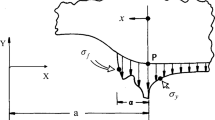Abstract
The results of 2D computer simulations of crack trajectories in an elastic material under a superposition of external uniaxial or biaxial tension and spatially random stress fluctuations are presented. The initial crack is straight. The criterion of maximum tensile stress near the crack tip is used to determine the crack trajectory. It is assumed that crack propagates in linear segments, step by step from either left or right tip depending on where the local circumferential stress is higher. Each segment is subjected to randomly-generated uniform tractions whose values are normally distributed with zero mean, independent of loads on previous segments. It is shown that the deflection of the actual crack paths from the trend increases with the crack length; its standard deviation grows stronger than predicted by the `random walk' model.
Similar content being viewed by others
References
Chakrabarti, B.K. and Benguigui, L.G. (1997). Statistical Physics of Fracture and Breakdown in Disordered Systems. Oxford Science Publications.
Cherepanov, G.P. (1979). Mechanics of Brittle Fracture. New York, McGraw-Hill.
Chudnovsky, A. and Kunin, B. (1987). A probabilistic model for brittle crack formation. J. Appl. Phys. 62, 4124.
Dyskin, A.V. (1999). On the role of stress fluctuations in brittle fracture. Int. J. Fracture 100, 29-53.
Dyskin, A.V., Galybin, A.N. and Kurtasov, S.F. (2002). Crack Growth in Materials with Defects: Modelling Based on Gaussian Stress Fluctuations. Structural Integrity and Fracture (Edited by A.V. Dyskin, X.Z. Hu and E. Sahouryeh), Swets & Zeitlinger, Lisse, 25-30.
Galybin, A.D., Dyskin, A.V. and Kurtasov, S.F. (2002). Simulation of stress fluctuations caused by voids in 2D elastic medium. 2nd International Conference on Advanced Computational Methods in Engineering (ACOMEN 2002), Liege University, Belgium, 28–31 May 2002). On CD-ROM (ISBN 2-930322-39-X)
Herrmann, H.J. and Roux, S. (1990). Statistical Models for the Fracture of Disordered Media.
Savruk, M.P. (1981). 2D problems of elasticity for bodies with cracks, Naukova Dumka, Kiev.
Author information
Authors and Affiliations
Rights and permissions
About this article
Cite this article
Galybin, A., Dyskin, A. Random trajectories of crack growth caused by spatial stress fluctuations. International Journal of Fracture 128, 95–103 (2004). https://doi.org/10.1023/B:FRAC.0000040971.81270.db
Issue Date:
DOI: https://doi.org/10.1023/B:FRAC.0000040971.81270.db




